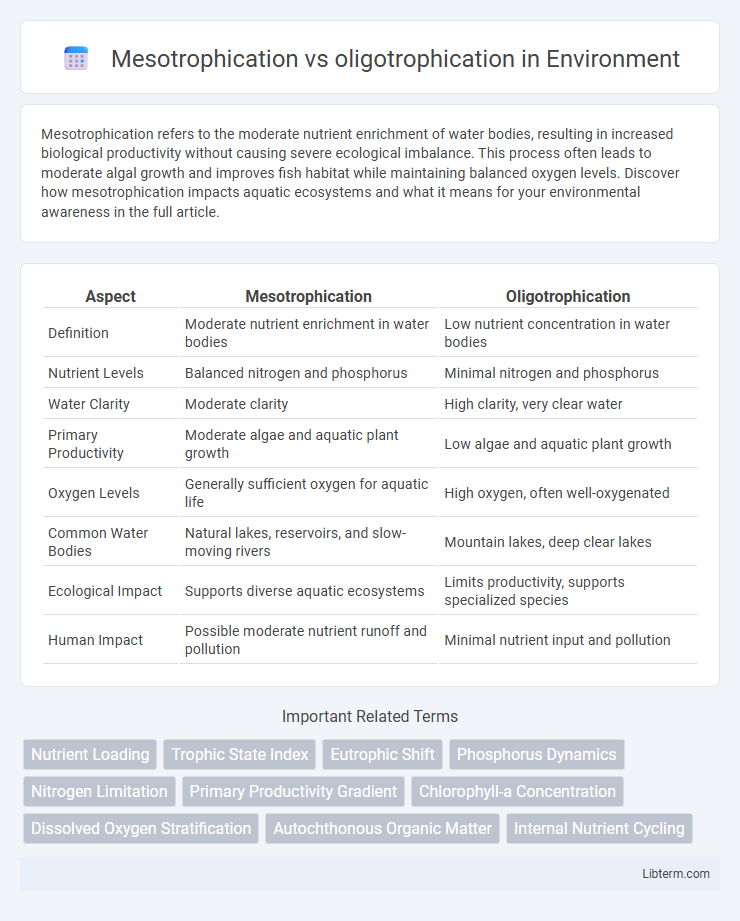Mesotrophication refers to the moderate nutrient enrichment of water bodies, resulting in increased biological productivity without causing severe ecological imbalance. This process often leads to moderate algal growth and improves fish habitat while maintaining balanced oxygen levels. Discover how mesotrophication impacts aquatic ecosystems and what it means for your environmental awareness in the full article.
Table of Comparison
| Aspect | Mesotrophication | Oligotrophication |
|---|---|---|
| Definition | Moderate nutrient enrichment in water bodies | Low nutrient concentration in water bodies |
| Nutrient Levels | Balanced nitrogen and phosphorus | Minimal nitrogen and phosphorus |
| Water Clarity | Moderate clarity | High clarity, very clear water |
| Primary Productivity | Moderate algae and aquatic plant growth | Low algae and aquatic plant growth |
| Oxygen Levels | Generally sufficient oxygen for aquatic life | High oxygen, often well-oxygenated |
| Common Water Bodies | Natural lakes, reservoirs, and slow-moving rivers | Mountain lakes, deep clear lakes |
| Ecological Impact | Supports diverse aquatic ecosystems | Limits productivity, supports specialized species |
| Human Impact | Possible moderate nutrient runoff and pollution | Minimal nutrient input and pollution |
Introduction to Aquatic Trophic States
Aquatic trophic states classify water bodies based on nutrient levels and biological productivity, with mesotrophic lakes exhibiting moderate nutrient concentrations that support balanced ecosystems, and oligotrophic lakes characterized by low nutrient availability and high oxygen levels, promoting clear waters and limited algal growth. Mesotrophication refers to the process where oligotrophic waters gradually increase in nutrient content, leading to enhanced primary productivity and potential shifts in aquatic communities. Understanding these trophic transitions is crucial for managing water quality and preserving aquatic biodiversity.
Defining Mesotrophication
Mesotrophication refers to the process where a water body transitions to a mesotrophic state, characterized by moderate nutrient levels and balanced biological productivity. This intermediate trophic condition supports diverse aquatic life without the excessive algal blooms typical in eutrophic systems. Understanding mesotrophication is crucial for managing nutrient inputs and maintaining healthy freshwater ecosystems.
Understanding Oligotrophication
Oligotrophication refers to the process of nutrient depletion in aquatic ecosystems, leading to low productivity and clear water conditions characterized by low concentrations of nitrogen and phosphorus. This phenomenon contrasts with mesotrophication, which involves moderate nutrient levels supporting balanced aquatic life. Understanding oligotrophication is crucial for managing water bodies affected by nutrient loss, ensuring biodiversity preservation and ecosystem stability in oligotrophic environments.
Causes and Drivers of Mesotrophication
Mesotrophication occurs when water bodies experience moderate nutrient enrichment, primarily due to increased nitrogen and phosphorus inputs from agricultural runoff, urban wastewater discharge, and atmospheric deposition. These excess nutrients stimulate algal growth and alter aquatic ecosystems, often driven by intensified land use and inadequate wastewater treatment. Unlike oligotrophication, which involves nutrient depletion, mesotrophication represents a transitional nutrient state influenced by anthropogenic activities affecting nutrient cycles.
Mechanisms Behind Oligotrophication
Oligotrophication occurs when nutrient levels, particularly nitrogen and phosphorus, decrease significantly in aquatic ecosystems, resulting in reduced primary productivity and clearer water conditions. This process is driven by factors such as enhanced nutrient uptake by biomass, increased sedimentation rates, or human interventions like nutrient load reduction through wastewater treatment and land-use management. In contrast to mesotrophication, which involves moderate nutrient enrichment and increased biological activity, oligotrophication signals a shift toward nutrient deficiency impacting ecosystem structure and function.
Ecological Impacts: Mesotrophication vs Oligotrophication
Mesotrophication leads to moderate nutrient enrichment in aquatic ecosystems, fostering increased biodiversity and productivity without causing severe algal blooms or oxygen depletion. Oligotrophication results in nutrient-poor conditions, limiting primary productivity and reducing species diversity but maintaining clearer water and higher oxygen levels. The ecological impacts differ as mesotrophic waters support balanced ecosystems with diverse flora and fauna, whereas oligotrophic environments sustain specialized species adapted to low-nutrient habitats.
Effects on Water Quality and Biodiversity
Mesotrophication, characterized by moderate nutrient enrichment, often enhances aquatic productivity but can lead to decreased water clarity and oxygen fluctuations, impacting sensitive species and promoting algal blooms. Oligotrophication, marked by low nutrient levels, maintains high oxygen content and water clarity, supporting diverse cold-water species but limiting overall biomass and productivity. Both processes significantly influence water quality and biodiversity by altering nutrient dynamics, oxygen availability, and habitat conditions in freshwater ecosystems.
Human Activities Influencing Trophic Changes
Human activities such as agricultural runoff, wastewater discharge, and deforestation significantly contribute to mesotrophication by increasing nutrient loads, especially nitrogen and phosphorus, in aquatic ecosystems. In contrast, oligotrophication can result from dam construction and water diversion that reduce nutrient inflow and sediment deposition, leading to lower productivity and nutrient availability. Urbanization and industrial pollution also alter trophic states by modifying nutrient cycles and water quality, impacting biodiversity and ecosystem functions.
Management and Restoration Approaches
Mesotrophication management involves controlling nutrient inputs, particularly nitrogen and phosphorus, through buffer zones, wastewater treatment, and sustainable agricultural practices to prevent further eutrophication. Oligotrophication restoration focuses on reintroducing essential nutrients and enhancing biological productivity by carefully managing water chemistry and sediment composition to support aquatic life. Adaptive monitoring and ecosystem-based approaches ensure balanced nutrient levels, promoting biodiversity and maintaining water quality in both mesotrophic and oligotrophic aquatic systems.
Future Trends and Research Directions
Future trends in mesotrophication research emphasize monitoring nutrient fluctuations to predict ecosystem shifts and mitigate eutrophication risks in freshwater bodies. Oligotrophication studies are increasingly focused on understanding carbon sequestration potential and the resilience of low-nutrient aquatic systems under climate change. Emerging technologies like remote sensing and molecular biomarkers are driving advancements in detecting early trophic state changes and guiding sustainable water management strategies.
Mesotrophication Infographic

 libterm.com
libterm.com